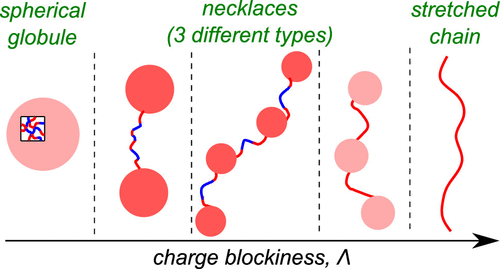当前位置:
X-MOL 学术
›
ACS Macro Lett.
›
论文详情
Our official English website, www.x-mol.net, welcomes your feedback! (Note: you will need to create a separate account there.)
Sequence Blockiness Controls the Structure of Polyampholyte Necklaces
ACS Macro Letters ( IF 5.8 ) Pub Date : 2021-07-28 , DOI: 10.1021/acsmacrolett.1c00318 Artem M Rumyantsev 1 , Albert Johner 2 , Juan J de Pablo 1, 3
ACS Macro Letters ( IF 5.8 ) Pub Date : 2021-07-28 , DOI: 10.1021/acsmacrolett.1c00318 Artem M Rumyantsev 1 , Albert Johner 2 , Juan J de Pablo 1, 3
Affiliation

|
A scaling theory of statistical (Markov) polyampholytes is developed to understand how sequence correlations, that is, the blockiness of positive and negative charges, influences conformational behavior. An increase in the charge patchiness leads to stronger correlation attractions between oppositely charged monomers, but simultaneously, it creates a higher charge imbalance in the polyampholyte. A competition between effective short-range attractions and long-range Coulomb repulsions induces globular, pearl-necklace, or fully stretched chain conformations, depending on the average length of the block of like charges. The necklace structure and the underlying distribution of the net charge are also controlled by the sequence. Sufficiently long blocks allow for charge migration from globular beads (pearls) to strings, thereby providing a nonmonotonic change in the number of necklace beads as the blockiness increases. The sequence-dependent structure of polyampholyte necklaces is confirmed by molecular dynamics simulations. The findings presented here provide a framework for understanding the sequence-encoded conformations of synthetic polyampholytes and intrinsically disordered proteins (IDPs).
中文翻译:

序列块状控制着两性电解质项链的结构
统计 (Markov) 聚两性电解质的标度理论被开发以了解序列相关性,即正负电荷的块状性如何影响构象行为。电荷不均匀性的增加导致带相反电荷的单体之间更强的相关吸引力,但同时,它会在聚两性电解质中产生更高的电荷不平衡。有效的短程吸引和长程库仑排斥之间的竞争会导致球状、珍珠项链或完全拉伸的链构象,这取决于类似电荷块的平均长度。项链结构和净电荷的底层分布也受序列控制。足够长的块允许电荷从球状珠子(珍珠)迁移到弦,因此,随着块状度的增加,项链珠子的数量会发生非单调变化。分子动力学模拟证实了聚两性电解质项链的序列相关结构。这里提出的发现为理解合成多两性电解质和内在无序蛋白质 (IDP) 的序列编码构象提供了一个框架。
更新日期:2021-08-17
中文翻译:

序列块状控制着两性电解质项链的结构
统计 (Markov) 聚两性电解质的标度理论被开发以了解序列相关性,即正负电荷的块状性如何影响构象行为。电荷不均匀性的增加导致带相反电荷的单体之间更强的相关吸引力,但同时,它会在聚两性电解质中产生更高的电荷不平衡。有效的短程吸引和长程库仑排斥之间的竞争会导致球状、珍珠项链或完全拉伸的链构象,这取决于类似电荷块的平均长度。项链结构和净电荷的底层分布也受序列控制。足够长的块允许电荷从球状珠子(珍珠)迁移到弦,因此,随着块状度的增加,项链珠子的数量会发生非单调变化。分子动力学模拟证实了聚两性电解质项链的序列相关结构。这里提出的发现为理解合成多两性电解质和内在无序蛋白质 (IDP) 的序列编码构象提供了一个框架。


























 京公网安备 11010802027423号
京公网安备 11010802027423号